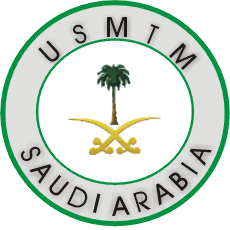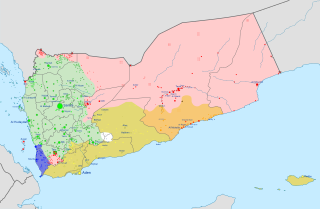
The Qatar Armed Forces are the military forces of the State of Qatar. Since 2015, Qatar has implemented mandatory military conscription with an average of 2,000 graduates per year. As of 2010, Qatar's defence expenditures added up to a total of $1.913 billion, about 1.5% of the national GDP, according to the SIPRI. Qatar has recently signed defence pacts with the United States in 2002 & 2013, with the United Kingdom in 2020, and with France in 1994.

The Saudi Arabian Armed Forces (SAAF), also known as the Royal Saudi Armed Forces, is part of the military forces of the Kingdom of Saudi Arabia. It consists of the Saudi Arabian Land Forces, the Royal Saudi Navy, the Royal Saudi Air Force, the Royal Saudi Air Defense, and the Royal Saudi Strategic Missile Force. The King of Saudi Arabia is the commander-in-chief of all the Military Forces and forms military policy with the Ministry of Defense and the Ministry of Interior. The five Armed Forces are among eight military forces of Saudi Arabia, with the others including the Saudi Arabian National Guard, the Saudi Royal Guard Regiment and Saudi Arabian Border Guards.

The Armed Forces of Yemen are the military forces of the Republic of Yemen. They include the Yemeni Army, Yemeni Navy and the Yemeni Air Force. The capital of the country, Sana’a is where the military is headquartered. Per the constitution of Yemen, the President of Yemen serves as the commander-in-chief.

King Abdulaziz Air Base, also known as Dhahran Air Base and formerly Dhahran International Airport, Dhahran Airport and Dhahran Airfield, is a Royal Saudi Air Force base located in Dhahran in the Eastern Province, Saudi Arabia. Located west of Thuqbah and 7 km (4 mi) southeast of the Saudi Aramco Dhahran Camp, the airbase was the first Saudi Arabian airport to be constructed, in 1961, and is under the command of Air vice-marshal Prince Turki bin Bandar bin Abdulaziz Al Saud.
The Saudi Arabian National Guard or SANG, also known as the "White Army", is one of the three major branches of the military forces of the Kingdom of Saudi Arabia.

The Croatian Army is the largest and most significant component of the Croatian Armed Forces (CAF).
Terrorism in Saudi Arabia has mainly been attributed to Islamic extremists. Their targets included foreign civilians—Westerners affiliated with its oil-based economy—as well as Saudi Arabian civilians and security forces. Anti-Western attacks have occurred in Saudi Arabia dating back to 1995. Saudi Arabia itself has been accused of funding terrorism in other countries, including Syria.
The Vinnell Corporation is an international private military company based in Herndon, Virginia, United States, specializing in military training, logistics, and support in the form of weapon systems maintenance and management consultancy. Vinnell Corporation is a subsidiary of Northrop Grumman Corporation. They are also party to other joint-venture companies, e.g. Vinnell-Brown & Root (VBR). The Vinnell Corporation was mentioned in Fahrenheit 9/11 for its connections to the Carlyle Group, George W. Bush, and the Saudi Royal family.
Beginning during Operation Desert Shield in August 1990, while preparing for the Gulf War, the United States sent a large troop contingent to Saudi Arabia. After the war, remnant troops, primarily U.S. Air Force personnel, augmented by a smaller number of coordinating and training personnel from the U.S. Navy, U.S. Army and U.S. Marine Corps remained in Saudi Arabia under the aegis of Joint Task Force Southwest Asia (JTF-SWA), as part of Operation Southern Watch (OSW). The United Kingdom and France also maintained a small contingent of Royal Air Force and French Air Force training personnel.

The Saudi Arabian Army, officially the Royal Saudi Land Forces, is the principle land warfare branch of the Armed Forces of Saudi Arabia. It is part of the Saudi Ministry of Defense, which is one of the two military departments of the government of Saudi Arabia, together with the Ministry of National Guard.

Articles related to Saudi Arabia include:

The United States Military Training Mission (USMTM) to the Kingdom of Saudi Arabia is a Security Assistance Organization (SAO) which manages and is primarily funded by Foreign Military Sales (FMS) cases between the United States Government and the Kingdom of Saudi Arabia. USMTM was the result of a meeting between King Abdul Aziz and United States President Franklin D. Roosevelt at Great Bitter Lake.

The United States Army Security Assistance Command (USASAC) – the 'Army's Face to the World' - implements security assistance programs, including Foreign Military Sales (FMS) of defense articles and services to eligible foreign governments. In addition, USASAC is responsible for the US Army's security assistance information management and financial policy and provides logistics guidance to the army's security assistance community. The command also supports the U.S. government's emergency assistance, humanitarian relief, and Operations Other Than War, including peacekeeping operations by the United Nations. The USASAC traces its origins to the Army's technical service era, and was designated a major subordinate command (MSC) of the U.S. Army Materiel Command (AMC) in 1975. Since its formation, USASAC has supported major US military operations and supported international peacekeeping and humanitarian efforts. The USASAC's motto is "Strength in Cooperation."
Eskan Village, officially named Eskan Village Compound, is a U.S. military compound located 20 kilometers south-east of Riyadh, Saudi Arabia. The base is home to the United States Military Training Mission in Saudi Arabia (USMTM), Office of the Program Manager Saudi Arabian National Guard Modernization Program (OPM-SANG), the Office of the Program Manager - Facilities Security Force (OPM-FSF), the Office of the Program Manager Ministry of Interior-Military Assistance Group (MOI-MAG) and
The al-Wadiah War was a military conflict which broke out on 27 November 1969 between Saudi Arabia and the People's Republic of South Yemen after PRSY forces seized the town of al-Wadiah on the PRSY-Saudi Arabian border. The conflict ended on 6 December when Saudi forces retook al-Wadiah.

On 26 March 2015, Saudi Arabia, leading a coalition of nine countries from West Asia and North Africa, launched an intervention in the Yemeni Civil War in response to calls from the president of Yemen Abdrabbuh Mansur Hadi for military support after he was ousted by the Houthi movement. The conflict ignited between the government forces, the Houthi rebels and other armed groups after the draft constitution and power-sharing arrangements collapsed, despite progress in the political transition led by the United Nations at that time, leading to an escalation of violence in mid-2014. The Houthis and allied units of the armed forces seized control of Sana’a and other parts of the country in September 2014 and in the following months. This prompted President Hadi to ask Saudi Arabia to intervene against the Iranian-backed Houthis.

Saudi Arabia and the Republic of China (ROC) have had a long relationship with deep diplomatic, military, and commercial elements. Relations formally existed until 1990 after which Saudi Arabia recognized the People's Republic of China (PRC).

On May 20, 2017, U.S. President Donald Trump and Saudi Arabia's Salman bin Abdulaziz Al Saud signed a series of letters of intent for the Kingdom of Saudi Arabia to purchase arms from the United States totaling US$110 billion immediately, and $350 billion over 10 years. The intended purchases include tanks, combat ships, missile defense systems, as well as radar, communications and cybersecurity technology. The transfer was widely seen as a counterbalance against the influence of Iran in the region and a "significant" and "historic" expansion of United States relations with Saudi Arabia.

The First Yemenite War was a short military conflict between the Yemen Arab Republic and the People's Democratic Republic of Yemen.

The Saudi Arabian Military Forces (SAMF) is the umbrella term for all the military forces of the Kingdom of Saudi Arabia. Although militarized in nature, each is independent of the other in that they fall under the control of different ministries and/or chain of command. They include: the Armed Forces of Saudi Arabia, the Saudi Arabian National Guard, the Saudi Arabian Border Guard, the Saudi Arabian Royal Guard, the Special Operations Forces, and the Special Security Unit.













